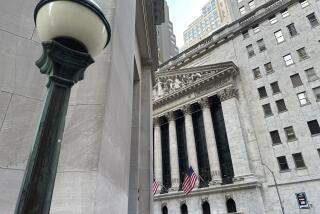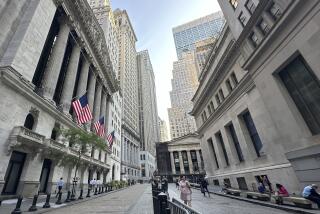FINANCIAL MARKETS : Stocks : Dow Off 5.49 for 7th Straight Drop
NEW YORK — Stock prices fell in slow uneventful trading Monday, as the market took a breather to await fresh news on the economy.
The Dow Jones index of 30 industrials fell 5.49 points to end the day at 2,376.47, its seventh consecutive decline. The blue chip indicator has lost 42.52 points since April 28.
The market opened lower on a carry-over from Friday’s last-minute selloff and in response to a weaker bond market ahead of this week’s three-day Treasury borrowing.
Prices drifted lower during the session as many big participants withdrew to await new data on the economy.
“The market is resting, consolidating with a little profit taking,” said Charles Jensen, chief technical analyst with MKI Securities Corp. “It’s waiting for more evidence about what the economy is going to do.”
The government is scheduled to report on retail sales and producer prices later this week.
Analysts said the market is concerned that producer prices could show that inflation is still a problem, which could lead to further credit tightening.
Declining issues outnumbered advancers by about 2 to 1 in nationwide trading of New York Stock Exchange-listed stocks, with 969 issues down, 504 up and 485 unchanged.
Volume on the floor of the Big Board came to 135.13 million shares, down from 180.81 million in the previous session.
Nationwide, consolidated volume in NYSE-listed issues, including trades in those stocks on regional exchanges and in the over-the-counter market, totaled 158.70 million shares.
Tokyo stocks climbed to a sixth straight record close Monday. The Nikkei index rose 180.25 points, or 0.53%, to a record close 34,135.24. It was the sixth straight record close for the Nikkei average and the seventh straight gain.
In London, stocks skidded in late trading Monday to end the day with a loss.
The Financial Times-Stock Exchange 100-share index closed down 13.2 points, or 0.6%, at 2,119.6, its lowest level of the day.
Currency
The dollar rose broadly in brisk U.S. trading as Federal Reserve intervention proved ineffective in deterring buyers.
Gold prices fell in the United States, reversing course after rising modestly overseas. Republic National Bank of New York quoted an ounce of gold bullion at $375.40 as of 4 p.m. EDT, $1.60 lower than Friday’s late bid.
In U.S. trading, the dollar ended at 1.9097 marks, up from 1.8977 on Friday, and piercing what was described as an important technical threshold of 1.90 marks. It was the highest closing level since August, 1988.
A variety of factors fed the dollar’s advance. Key catalysts were comments by the president of West Germany’s central bank and the fact that the dollar remained above levels identified as significant from a technical standpoint, despite Fed intervention.
Bundesbank President Karl Otto Poehl indicated that the dollar’s value against other major currencies is a matter being decided by the markets and countries that would have to live with the decision.
Speaking in Basel, Switzerland, after a regular meeting of the Group of 10 central bankers, he said the dollar’s strength is remarkable given the trade imbalances among leading industrialized countries.
Foreign exchange dealers interpreted his remarks to imply that government monetary authorities are unlikely to act aggressively to influence the dollar.
On the Commodity Exchange in New York, gold for current delivery settled at $376.90, down from $377.70 on Friday.
Commodities
Copper futures prices tumbled on New York’s Commodity Exchange following an unexpectedly large increase in warehouse stocks of copper reported by the London Metal Exchange.
On other markets, palladium surged while gold and silver prices slipped; energy futures plummeted; grains and soybeans were mostly lower; cattle futures dipped, and pork prices advanced.
Copper settled 2.7 cents to 5.2 cents lower, with the spot contract for delivery in May at $1.259 a pound and the most active contract, for July delivery, at $1.216 a pound.
Credit
A strong dollar and a reassessment of the government’s latest employment figures pushed bond prices lower.
The Treasury’s benchmark 30-year bond fell 3/8 point, or $3.75 for every $1,000 in face value. Its yield, which moves in the opposite direction from its price, rose to 8.99% from 8.95% late Friday.
Robert Brusca, chief economist for Nikko Securities International Inc., said the market declined on a belief that a government report showing civilian unemployment up 0.3 percentage point at 5.3% was less positive than initially interpreted.
The federal funds rate, the interest on overnight loans between banks, was quoted late in the day at 9.75%, up from 9.8125% late Friday.
Tables begin on Page 10.
More to Read
Inside the business of entertainment
The Wide Shot brings you news, analysis and insights on everything from streaming wars to production — and what it all means for the future.
You may occasionally receive promotional content from the Los Angeles Times.










